Capping the Wells
North Louisiana is home to thousands of small oil wells, many dormant for decades. Greg Wall, area engineer for the state highway agency, says procuring the land was one of the first project challenges.
The new interstate was designed to run through an oilfield area in North Caddo Parish that dates back to the early 1900s. Many landowners originally thought the state would pay between $5,000 and $20,000 per acre, he says. But because the state does not purchase mineral rights—they are retained by the landowner—the per-acre offer, in most cases, was $1,000.
As a result, land procurement took longer than expected, according to Wall. A bigger issue was dealing with the oil wells, since many of them were drilled in the 1920s and detailed location information was unavailable or incomplete.
Wall says the oil companies were cooperative, but many wells could not be found until workers were in the field for land-clearing. "One oil company had about 300 wells it had to plug or fool with," he says. "It was just a large number of wells, some of which we didn't know about until later."
Over the span of James Construction's four projects, Rogers says workers discovered about a dozen wells that were previously not noted in the plans. Each had to be assessed individually by crews from the state Dept. of Environmental Quality to determine whether or not the well had been plugged, although he says the added analyses did not cause cumulative delays to the project.
"You would just happen across a piece of vertical pipe protruding from the ground. You didn't know where these things were until you started clearing," Rogers says. "Fortunately, we were able to identify those early in the job and it didn't cause any setbacks."
Revisions and Rebuilds
With 30 bridges under the James Construction contracts, extensive design work was required to tie into existing roadways. Wall says the team encountered bridge design issues in the first segment. The design called for steel girder bridges over all state roads, but Wall says some of the plans specified the slope of one bridge in the wrong direction.
When workers started setting the girders, they discovered that they had to modify the bridge. The team had to wait for design revisions and rebuild the deck, causing delays, Wall says. "It set us back about a month or a month and a half," he says. "Normally … it's right, but things do happen and people miss things."








Post a comment to this article
Report Abusive Comment